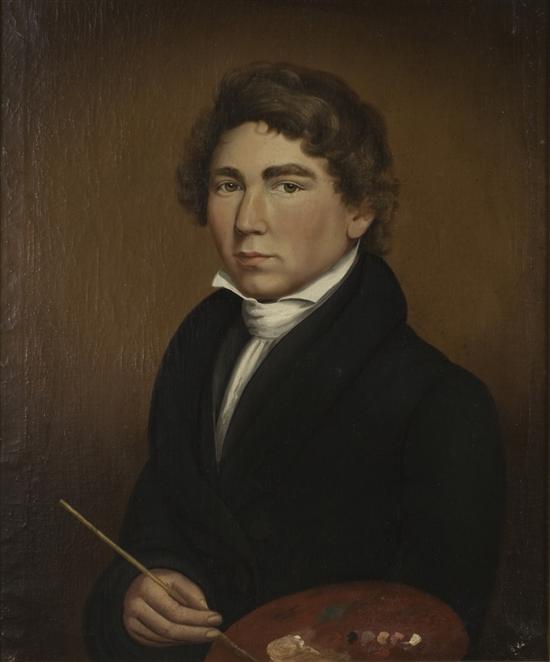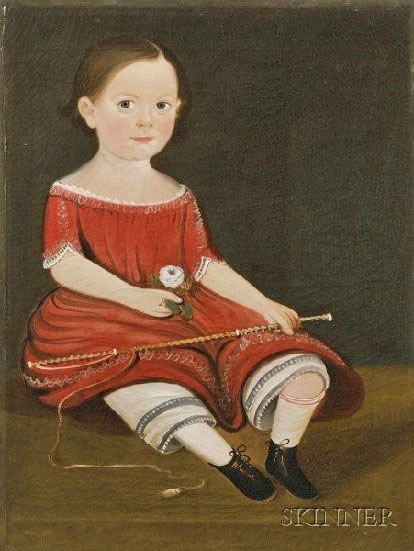William Matthew Prior (1806 to 1873)
In the decades just before the advent of photography, a solid middle class began to form in America, a middle class that sought to aspire to and attempt to replicate some of the finer things of the upper class. Portraits were some of the most visible and sentimental of these objects, and as a result, portrait painters (or limners, as they were sometimes called) began to flock to urban areas to establish themselves or to travel the countryside, stopping in rural communities where they would rent a room for several weeks and advertise their services in the local newspapers, moving on when business began to slow down. While the degree of natural talent often varied, these men often lacked the background and financial resources to secure formal training or education, and as a result, the portraiture they created, identified as folk portraiture, has a distinctive flat style that is very linear in construction and lacking shading and other artistry typically acquired from art studies.
William Matthew Prior, born in Bath, Maine in 1806, the second son of Matthew Prior, a shipmaster, and his wife Sarah, became such an artist. As with many figures of the period, little is known about Prior’s early life or training, but we do know, courtesy of an inscription on a portrait, that by 1824 at the age of eighteen, he was working as an artist. For several years, he continued to work along the coast of Maine with the occasional ad for his portrait services turning up in newspapers.

William Matthew Prior self-portrait. (p4A item # D9701766)
In 1828, Prior was working in the Portland area where he married Rosamund Clark Hamblen, a member of a family of artists, and the Priors remained in Portland for more than a decade until William Prior and his brothers-in-law, Nathaniel, Joseph and Sturtevant Hamblen all relocated to Boston in 1839. (Note: the Hamblen name is also occasionally seen as Hamblin, but for purposes of continuity, we have adopted the spelling Hamblen based on Falk’s Who’s Who in American Art and The Getty Research Institute.) Their work forms the basis for what is known as the Prior-Hamblen School, a group that is loosely defined and includes an unknown number of artists, as one of the characteristics of the group is that their paintings are so frequently unsigned and so similar on a number of points as to be indistinguishable from each other.
Prior’s portraits, like most of the Prior-Hamblen group, are mostly unsigned and characterized by a flatness with simplistically-outlined figures and little or no background decoration. This distinctive style had the added practicality of being quick and thus cost effective. Indeed, Prior is known to have advertised on several occasions to the effect that ‘Persons wishing for a flat picture can have a likeness without shade or shadow at one quarter the price’ and that he could produce a portrait likeness in one hour, an efficient rate that allowed him to keep pricing low and to compete more directly in price with daguerreotypes. However, this same adaptability can make attributing portraits to Prior difficult. With folk portraits, the assumption often is that the portraits lack shading and depth because the artist lacked skill, but Prior and other artists with large catalogues challenge this line of thinking. The evidence would indicate that Prior had substantial skill, regardless of the degree of training he may or may not have received, and was capable of painting in a more ‘academic’ style. The folksy flat style for which he and the other Prior-Hamblen artists are known is, at least in Prior’s case, more characteristic of financial and business skills than artistic ones.

A Prior portrait of a woman, exhibiting a different level of refinement and skill than many of his folk portraits. (p4A item # C217687)
For several years the families apparently shared quarters, but by 1846, Prior and his wife were able to move to Trenton Street in East Boston, where they were to remain. Their new home allowed Prior to open his own studio, ‘The Painting Garret’ as he called it, on the property, and until his death in 1873, Prior worked steadily at portraiture.
He was not, however, limited to Boston patronage. He is known to have painted portraits for customers as far south as Baltimore, Maryland, and indeed, when business in Boston would temporarily ebb (as it invariably did after Charles Daguerre’s invention, the daguerreotype, introduced in 1839, caught on in popularity and affordability throughout the 1850s), he would take to the roads and rails of New England, working as an itinerant portrait painter, boarding with his clients or exchanging services for room and board at inns and boardinghouses; and, as with most artists of the time, he turned his talents to any endeavor requiring artistic efforts in order to make a little extra money. Prior is known to have decorated furniture and clocks, to have executed the occasional landscape or copy of a print, and even to have turned his hand to painting signs.
A deeply religious man who supported the Abolitionist and Adventist movements, Prior also wrote several books on religion, but left relatively few religious paintings, although all his works remain very popular today. His portraits, along with Prior-Hamblen School portraits in general, are routinely very desirable and perform well at auction. In particular, Prior’s portraits of children are considered especially collectible, perhaps because something about his flat, simple style complements the simplicity and innocence of childhood.

Prior portrait of a young boy. (p4A item # D9841237)
A prolific artist, Prior left enough of a record for many of his works to be identified by experts, even though they may be unsigned. His portraiture can be found in a vast number of institutions, from large collections to smaller regional museums, including such illustrious collections as the Abby Aldrich Rockefeller and the DeWitt Wallace Collection in Colonial Williamsburg, the Museum of American Folk Art in New York, and the Museum of Fine Arts in Boston.
Hollie Davis, p4A Senior Editor, March 8, 2010
